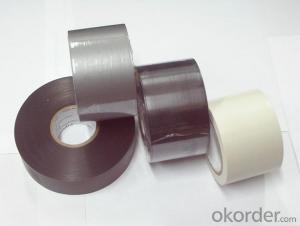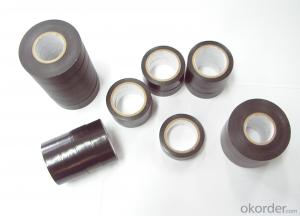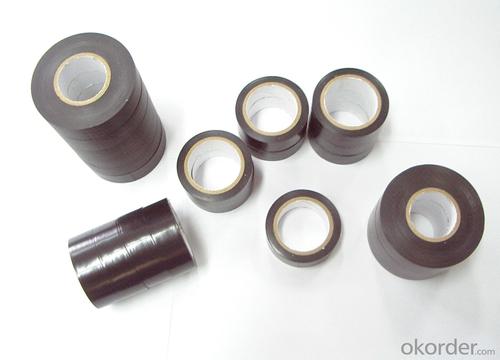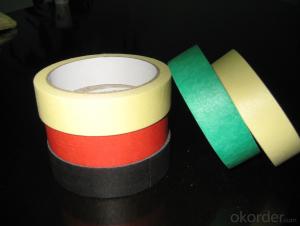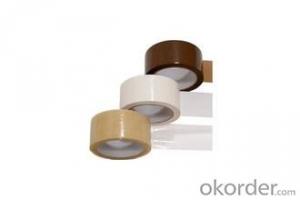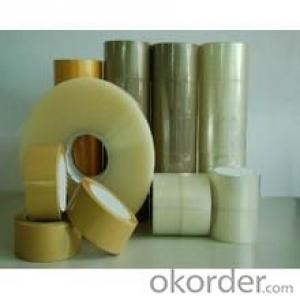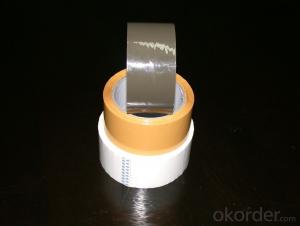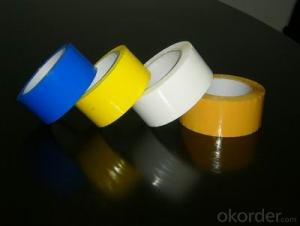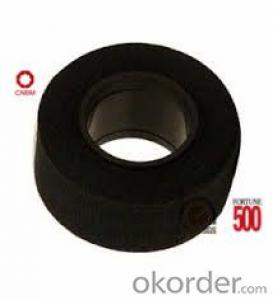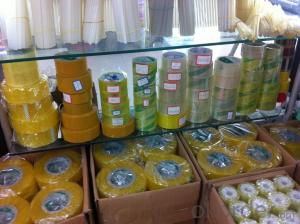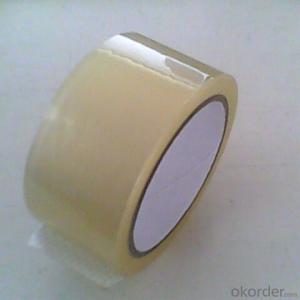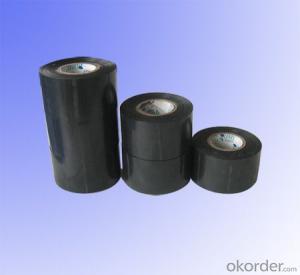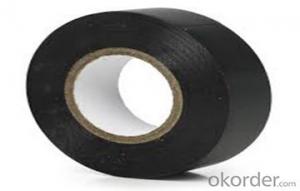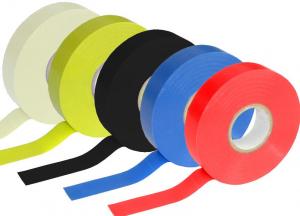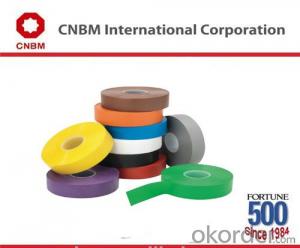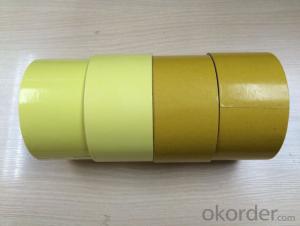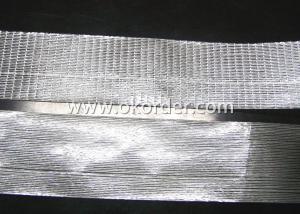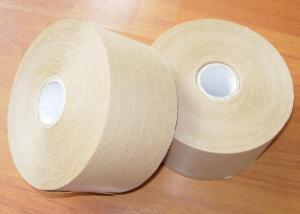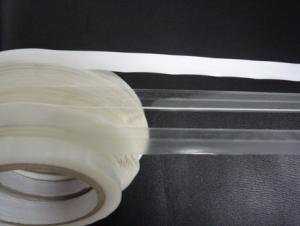OPP Packaging Tape Quotes - High Quality PVC Tape Wonder Black Pipe Wrapping Tape
- Loading Port:
- China main port
- Payment Terms:
- TT OR LC
- Min Order Qty:
- 1000 roll
- Supply Capability:
- 1000000 roll/month
OKorder Service Pledge
OKorder Financial Service
You Might Also Like
Introduction of PVC Tape
PVC tapes are made of soft pvc film coated with rubber pressure-sentitive adhesive.
Application of PVC Tape
PVC tapes are widely used in auto harness, wrapping of wire, and insulation protection. It is the main insulation material of automobilehousehold electrical apparatus.
Advantage of PVC Tape
Corrosion protection for metal piping systems above and below ground.
Corrosion protection for fittings and joints on mill coated pipe.
Corrosion protection of electrical conduit & fittings.
Resists corrosive action by salt water, soil acids, alkalies and salts.
Prevents dielectric corrosion between buried steel pipe and soil minerals.
Packing of PVC Tape
Jumbo rolls & log rolls: Packed with kraft paper and stretch wrap film, with or without pallet.
Cut rolls: Shrink package, placed in cartons, with or without pallet.
Jumbo rolls & log rolls: Packed with kraft paper and stretch wrap film, with or without pallet.
Size of PVC Tape
Paper Core ID: 32mm, 38cm
Jumbo size: 1.25m x 20m, 1.25m x 33, 1.25m x 50m
Cut roll size: As per customer's requirement
Cut rolls: Shrink package, placed in cartons, with or without pallet
Pictures of PVC Tape
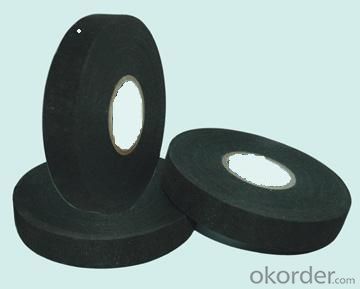
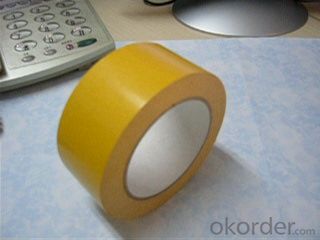
Specification of PVC Tape
| Carrier | Soft PVC film |
| Adhesive side | Single side |
| Adhesive | Rubber pressure-sentitive adhesive |
| Color | White/yellow/black/orange /brown/blue/red/ green |
| Normal thickness | 130mic,150mic, 160mic, 170mic, 180mic, 190mic, 200mic |
| Packaging | Single packed, shrink film packed, depend on customer’s request |
Remarks:
1. The data above are typical results and subject to change without notice.
2. Tolerance: Weight and Thickness: ±10%; Width: ±3mm;
Length: Cut Roll & Log Roll ±0.3m, Jumbo Roll ±0.5%.
3. The products should be stored at room temperature and kept from wet and heat source.
4. It is essential, as with all pressure-sensitive tapes, that the surface to which the tape is applied must be clean, dry, and free of grease and oil.
5. The user should take test and do trial-application on the above products before coming into application so as to witness and ensure suitability for user’s special purpose and technique.
FAQ
1. What is the range of your products?
So far, we manufacture various kinds of double sided adhesive tape, masking tape, kraft tape and BOPP packing tape. To better meet your needs, we can also source other adhesive tapes for you if it is appropriate to do so.
2. What's the lead time for delivery?
We ensure you a prompt delivery of the goods. We do not stock any of the goods. The production cycle time of 1*20FCL is 2-3 weeks.
3. How many carriers does your double sided adhesive tapes have?
There are many carriers that our double sided adhesive tapes based on, which are tissue, PET, BOPP, PE foam, EVA foam.
4.Can you accept the cooperation way of OEM?
Upon receipt of formal authorization, we can accept OEM processing.
- Q: Can packaging tape be used for sealing plastic pet carriers?
- Yes, packaging tape can be used for sealing plastic pet carriers.
- Q: Is packaging tape transparent?
- Indeed, transparency can be found in packaging tape. Various forms of packaging tape are manufactured using clear substances like polypropylene or acrylic, which enable them to possess a see-through quality. The advantage of this transparency lies in its ability to allow users to effortlessly view the contents of a package without the need for unwrapping. Furthermore, transparent packaging tape is often favored in situations where a polished and professional appearance is desired, as it effortlessly blends with diverse packaging materials. Nonetheless, it is worth mentioning that not all packaging tapes possess transparency, as there are also options available in colored or printed variations that cater to specific purposes or branding requirements.
- Q: Does packaging tape come in different dispenser options for ease of use?
- Packaging tape is available in different dispenser options, making it easier to use. The market offers various types of dispensers that are specifically designed to simplify the process of sealing boxes or packages. These dispensers come in different sizes, styles, and functionalities to accommodate different needs and preferences. One popular type of dispenser is the handheld dispenser. It is lightweight and compact, making it easy to handle and maneuver. These dispensers usually have a serrated blade for cutting the tape and a comfortable grip for better control. They are ideal for small to medium-sized packaging tasks. For larger packaging jobs, tabletop or benchtop dispensers are available. These dispensers are designed to sit on a surface and securely hold the tape roll in place, allowing for efficient and continuous taping. They often have a built-in cutting mechanism for easy and precise tape cutting. Moreover, there are automatic or electric dispensers that offer even more convenience. With these dispensers, you can effortlessly dispense and cut the tape with the push of a button, saving time and effort. They are especially useful for high-volume or repetitive packaging needs. To summarize, different dispenser options are available for packaging tape to cater to various preferences and requirements. Whether you need a handheld dispenser for small tasks or an automatic dispenser for larger volumes, there are dispenser options that can enhance the ease of use and efficiency of your packaging process.
- Q: Can packaging tape be used for sealing glass containers?
- Yes, packaging tape can be used for sealing glass containers. Packaging tapes are designed to provide a strong and secure seal on a variety of surfaces, including glass. When properly applied, the tape adheres firmly to the glass surface, creating a tight seal that helps to keep the contents of the container protected. However, it's important to note that not all packaging tapes are suitable for use with glass containers. It is recommended to use a tape specifically designed for glass or a heavy-duty packaging tape that has strong adhesive properties to ensure proper sealing.
- Q: Can packaging tape be used for sealing packages with high-value contents?
- Yes, packaging tape can be used for sealing packages with high-value contents. Packaging tape is specifically designed to securely seal packages, providing protection against tampering, moisture, and damage during transit. It is strong, durable, and often features a strong adhesive backing that creates a long-lasting seal. When applied properly, packaging tape can effectively secure packages containing high-value contents, ensuring their safe delivery. However, it is important to consider additional security measures, such as using tamper-evident tape or adding extra layers of protection, depending on the value and fragility of the contents.
- Q: Does packaging tape have any specific certifications or standards?
- Yes, packaging tape can have specific certifications or standards. Some common certifications or standards for packaging tape include ISO 9001 (quality management), ISO 14001 (environmental management), and ASTM D1974 (standard specification for sealing and securing pressure-sensitive tape for packaging). Additionally, certain industries may have their own specific certifications or standards for packaging tape, such as food-safe certifications for packaging tape used in the food industry.
- Q: Is packaging tape safe to use on ceramic tiles?
- Yes, packaging tape is generally safe to use on ceramic tiles. Packaging tape is designed to adhere to a variety of surfaces, including ceramic tiles. However, it is important to ensure that the tape is removed carefully to avoid damaging the tile or leaving any residue behind. It is recommended to test a small inconspicuous area first to ensure that the tape does not cause any damage or discoloration. Additionally, it is always a good idea to follow the manufacturer's instructions and guidelines for using packaging tape on specific surfaces.
- Q: Can packaging tape be used for sealing packages with heavy-duty construction materials?
- Indeed, packaging tape possesses the capability to seal packages that encompass robust construction materials. Its purpose lies in furnishing powerful adhesion and endurance, rendering it fitting for the task of safeguarding packages harboring heavy-duty construction materials. Nevertheless, it is of utmost importance to meticulously select a packaging tape exclusively engineered for heavy-duty applications, such as reinforced or exceptionally potent tape, in order to guarantee proper sealing and secure transportation. Moreover, it is prudent to fortify the packaging through the utilization of supplementary tape or protective wrapping, contingent upon the weight and fragility of the construction materials, for the purpose of ensuring a safe and secure delivery.
- Q: Does packaging tape come in different dispenser designs for ergonomic use?
- Yes, packaging tape does come in different dispenser designs for ergonomic use. Many manufacturers offer dispenser options that are specifically designed to be more comfortable and user-friendly for extended periods of use. These designs often feature features such as cushioned handles, ergonomic grips, and adjustable tension control to reduce strain and fatigue on the hand and wrist. Additionally, some dispensers may have a lightweight and compact design, making them easier to handle and maneuver. These ergonomic dispenser designs aim to improve productivity and reduce the risk of injuries or discomfort associated with repetitive tape dispensing tasks.
- Q: Can packaging tape be used for sealing pharmaceutical or medical supplies?
- Indeed, the utilization of packaging tape is viable for the sealing of pharmaceutical or medical supplies. Nevertheless, it is crucial to acknowledge that not every packaging tape is appropriate for such a function. It is advisable to opt for packaging tapes that are explicitly crafted for medical or pharmaceutical applications. These tapes frequently consist of materials that offer a robust and dependable seal, guaranteeing the inviolability and well-being of the contents. Furthermore, medical or pharmaceutical packaging tapes might also possess distinctive characteristics like tamper-evident properties or sterilization indicators to fulfill the precise demands of these sectors.
Send your message to us
OPP Packaging Tape Quotes - High Quality PVC Tape Wonder Black Pipe Wrapping Tape
- Loading Port:
- China main port
- Payment Terms:
- TT OR LC
- Min Order Qty:
- 1000 roll
- Supply Capability:
- 1000000 roll/month
OKorder Service Pledge
OKorder Financial Service
Similar products
Hot products
Hot Searches
Related keywords
